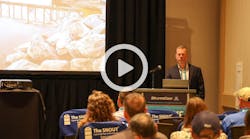Project Profile: Shoreline Protection Revitalizes Airport’s Coast
Many don’t know that it takes about 500 years to replace 1 inch of topsoil lost to erosion. Soil is often perceived as a renewable resource that quickly repopulates itself, but in reality, it isn’t really renewable at all. Not in our lifetime, at least. This slow rate of repopulation is a major concern for environmental scientists and engineers alike because soil is essential for securing not only plants and trees, but our infrastructure as well.
Soil erosion has a significant impact on our ecosystem. In the US alone, soil is eroding 10 times faster than the natural soil replenishment rate, and about 60% of the soil being washed away ends up in rivers, streams, lakes, bays, estuaries, and gulfs. This ultimately degrades our waters. And to make matters worse, the eroding sediment particles are frequently laden with fertilizers and pesticides from lawns and farms. These pollute the waters and cause algal blooms that deplete oxygen in the water, resulting in the death of fish.
In the aviation industry, especially at airports located along the coastal areas, erosion and aging infrastructure are primary concerns. Many airports in the US are former World War II military airfields built long before the existence of the Federal Aviation Administration (FAA) design guidelines and safety requirements, and regional and local building codes.
One of the runways sits on a peninsula.
Over the years, these coastal airports have lost land to storms, tornadoes, and hurricanes because their shorelines either had no protection or had old bulkheads that were designed to retain soil but provided minimal protection from waves. These older shoreline stabilization and protection techniques consisted of bulkheads and seawalls made with concrete, steel, aluminum, or timber, and generally had a service life ranging between 10 and 30-plus years—depending on maintenance of the structure. As these vertical soil-retaining structures are typically designed only for 30-year storms, as they age, the structures eventually collapse and result in erosion in varying degrees. This loss of uplands can be highly detrimental to passenger safety, as it generally results in insufficient safety areas for planes to land and take off.
To address safe aircraft operations, which include eroding shorelines at airports, the FAA created the Runway Safety Area (RSA) Program in 2000. According to the FAA airport design and engineering standards contained in FAA Advisory Circular 150/5300-13, Airport Design, “The RSA is intended to provide a measure of safety in the event of an aircraft’s excursion from the runway by significantly reducing the extent of personal injury and aircraft damage during overruns, undershoots, and veer-offs.”
The ever-evolving RSA directly places responsibilities for determining need in the hands of the FAA Regional Airports Division, who must decide the level of detail required for all planning, environmental, and engineering factors that are to be incorporated in analyzing the practicable alternatives. To date, the RSA Program has funded $13.7 billion of airport infrastructure improvements, including shoreline stabilization projects at several coastal airports that had eroding and failing RSAs.
Native plants grow through the open-cell articulated blocks.
One such project is the runway safety area improvements and shoreline stabilization project at the Merritt Island Airport in Brevard County, FL. The airport—originally built in 1940 as a Mosquito Control District airport—features a runway that sits directly on a peninsula surrounded by the Banana River Aquatic Preserve. Just several feet below the end of the airport’s Runway 29 shoreline, the remnants of an old bulkhead remain visible in the river. The airport has endured 80 hurricanes since 1940—the largest was Ginny in 1963 and the most recent was Arthur in 2014—which resulted in a deficient RSA that continued to erode from hurricane- and storm-driven waves and stormwater runoff overland flow.
This deficient runway safety area was a concern not only from an environmental perspective, but also from a passenger safety standpoint. From 1988 to 2014, 34 incidents were reported involving airplanes rolling off the runway—some into the river—resulting in aircraft damage and minor injuries. One of the incidents involved a plane that landed long (after the threshold of the runway) on Runway 11, then overran the end of Runway 29 and the existing deficient RSA, and ended up in the water. The lack of sufficient RSA on the end of Runway 29 may have been a contributing factor to an increased amount of aircraft and property damage and human injury. To help reduce these incidents, a project was proposed that called for stabilizing the eroding shoreline and filling in part of the river as a means to extend the RSA to comply with appropriate FAA design guidelines and safety requirements, and to prevent future loss of land that would eventually compromise the runway.
The Titusville-Cocoa Airport Authority, which operates the airport, had been trying to acquire grant funding to address the eroding shoreline and deficient RSA at Merritt Island Airport for several years and finally received FAA grant funding to proceed with the much-needed project.
As an environmental steward that actively promotes sustainable development, Michael Baker International was hired to design a resilient project that would protect the shoreline from storms and overland flow of stormwater runoff and stop erosion, mitigate the unavoidable natural resource impacts, and help improve the ailing river.
Because of the project’s location along the coast, there were unavoidable impacts to wetlands, marshes, aquatic preserves, seagrasses, oyster beds, and habitats for fish, manatees, and other protected species. State and federal laws protect these waters and the species that live in and depend on them, and advocacy from public and private interest groups also limits development in the waters. After evaluation of these considerations and challenges, a complex mitigation plan was developed to compensate for impacts. The plan included of a seagrass island platform, an off-site mosquito impoundment enhancement wetland mitigation area, and a green shoreline protection structure.
Resilient Shoreline Protection
After reviewing the coastal processes expected at the Merritt Island Airport, the team formulated a 100-year storm design condition for water level and wave height along the shoreline. These conditions were used to calculate basic design elements of the articulated concrete block mat revetment for shoreline protection. Design specifications were developed to ensure that the armored shoreline would be resistant to scour and uplift by wave forces, effectively stopping erosion and sediment deposition into the river—ultimately improving water quality.
To further help prevent soil erosion, an open-cell articulated block was used to allow for the planting and growth of native flora along the shoreline. The native grasses and coastal plant species planted on the top of the riverbank and safety area help prevent erosion and provide passive stormwater runoff treatment, wildlife habitat, and carbon sequestration. Following the improvements, the armored shoreline now has an anticipated shoreline protection life span of 75 years or more.
For the off-site mitigation area, exotic and invasive tree species were cut at the base and treated with the appropriate herbicide. The majority of the trees were located along the shoreline of the wetland island, so the invasive trees’ root systems were left intact to maintain the integrity of the shoreline and prevent soil erosion. The shoreline was also densely planted with native salt-tolerant wetland plants and mangroves to enhance shoreline stabilization and create native wildlife habitat.
As Michael Powell, chief executive officer of the Titusville-Cocoa Airport Authority, explains, “This is an exemplary project considering that we had nothing before. The shoreline had eroded and started to eat away at the area next to the runway.” He adds, “We went from a deficient runway safety area to one that exceeds FAA standards.”
The efforts that the team employed to revitalize the coastline at the Merritt Island Airport showcase how shoreline protection, erosion control, and resilient design can be incorporated into sustainable airport development.
As environmentalists, we need to be on the forefront, championing the protection of the soil that we have left to ensure we stop losing ground. At coastal airports especially, it is paramount to protect soil and shoreline as they are exposed to the elements and take a beating from frequent inclement weather. This will ensure we can preserve these unique airports and prevent passenger injuries. It is essential that planners, designers, engineers, and scientists work together to develop a plan that will protect our soil and infrastructure, while also protecting our ecological systems.






